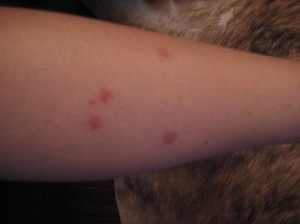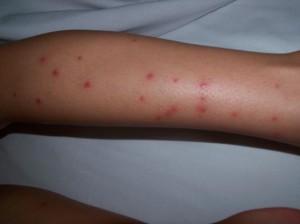

Bed bugs bite and suck blood from humans. Bed bugs are most active at night and bite any exposed areas of skin while an individual is sleeping. The face, neck, hands, and arms are common sites for bed bug bites. The bite itself is painless and is not noticed. Small, flat, or raised bumps on the skin are the most common sign; redness, swelling, and itching commonly occur. If scratched, the bite areas can become infected. A peculiarity of bed bug bites is the tendency to find several bites lined up in a row. Infectious disease specialists refer to this as the "breakfast, lunch, and dinner" sign signifying the sequential feeding that occurs from site to site.
Bed bug bites may go unnoticed or be mistaken for flea or mosquito bites or other types of rash or skin conditions. Bed bugs also have glands whose secretions may leave odors, and they also may leave dark fecal spots on bed sheets and around their hiding places (in crevices or protected areas around the bed or anywhere in the room).
Bed bugs have not been conclusively proven to carry infectious microbes; however, researchers have implicated bed bugs as possible vectors of American trypanosomiasis (Chagas disease), and studies are ongoing to determine whether bed bugs may serve as disease carriers.











